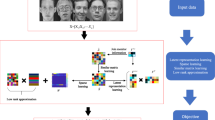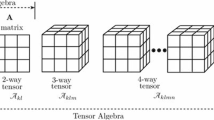Abstract
Efficient low-rank representation of data plays a significant role in the field of computer vision and pattern recognition. In order to obtain a more discriminant and sparse low-dimensional representation, a novel non-negative enhanced discriminant matrix factorization method with sparsity regularization is proposed in this paper. Firstly, the local invariance and discriminant information of the low-dimensional representation are incorporated into the objective function to construct a new within-class encouragement constraint term, and the weighted coefficients are introduced to further enhance the compactness between the samples that belong to the same class in the new base space. Secondly, a new between-class penalty term is constructed to maximize the difference between different classes of samples, and meanwhile, the weighted coefficients are introduced to further enhance the discreteness and discriminativeness between classes. Finally, to learn the part-based representation of data better, the sparse constraint term is further introduced, and consequently, the sparseness of data representation, the local invariance, and the discriminativeness are integrated into a unified framework. Moreover, the optimization solution and the convergence proof of objective function are given. The extensive experiments demonstrate the strong robustness of the proposed method to face recognition and image classification under occlusions.


























Similar content being viewed by others
References
Jolliffe IT (1989) Principal component analysis. Springer, New York
Fisher RA (1936) The use of multiple measurements in taxonomic problems. Ann Eugenics 7(2):179–188
Shahid N, Kalofolias V, Bresson X et al (2015) Robust principal component analysis on graphs. In: IEEE conference on computer vision, pp 2812–2820
Hu Z, Pan G, Wang Y et al (2016) Sparse Principal Component Analysis via rotation and truncation. IEEE Trans Neural Netw Learn Syst 27(4):875–890
Lu M, Huang JZ, Qian X (2016) Sparse exponential family Principal Component Analysis. Pattern Recogn 60:681–691
Khalid MI, Alotaiby T, Aldosari SA et al (2016) Epileptic MEG spikes detection using common spatial patterns and linear discriminant analysis. IEEE Access 4:4629–4634
Ye Q, Yang J, Liu F et al (2016) L1-norm distance linear discriminant analysis based on an effective iterative algorithm. IEEE Trans Circuits Syst Video Technol 99:1–1
Lee DD, Seung HS (2001) Algorithms for non-negative matrix factorization. In: Advances in neural information processing systems, pp 556–562
Trigeorgis G, Bousmalis K, Zafeiriou S et al (2017) A deep matrix factorization method for learning attribute representations. IEEE Trans Pattern Anal Mach Int 39(3):417–429
Sun F, Xu M, Hu X et al (2016) Graph regularized and sparse nonnegative matrix factorization with hard constraints for data representation. Neurocomputing 173(2):233–244
Zhang R, Hu Z, Pan G et al (2016) Robust discriminative non-negative matrix factorization. Neurocomputing 173(3):552–561
Wang D, Gao X, Wang X (2016) Semi-supervised nonnegative matrix factorization via constraint propagation. IEEE Trans Cybern 46(1):233–244
Li J, Bioucas-Dias JM, Plaza A et al (2016) Robust collaborative nonnegative matrix factorization for hyperspectral unmixing. IEEE Trans Geosci Remote Sens 54(10):6076–6090
Tepper M, Sapiro G (2016) Compressed nonnegative matrix factorization is fast and accurate. IEEE Trans Sig Process 64(9):2269–2283
Liu JX, Wang D, Gao YL et al (2017) Regularized non-negative matrix factorization for identifying differential genes and clustering samples: a survey. IEEE/ACM Trans Comput Biol Bioinform 99:1-1
Li SZ, Hou XW, Zhang HJ et al (2001) Learning spatially localized, parts-based representation. In: IEEE conference on computer vision and pattern recognition, pp 207–212
Hoyer PO (2004) Non-negative matrix factorization with sparseness constraints. J Mach Learn Res 5:1457–1469
Yang Z, Xiang Y, Xie K et al (2016) Adaptive method for nonsmooth nonnegative matrix factorization. IEEE Trans Neural Netw Learn Syst 28(4):948–960
Jia YWY, Turk CHM (2004) Fisher non-negative matrix factorization for learning local features. In: Proceedings of Asian conference on computer vision, pp 27–30
Zafeiriou S, Tefas A, Buciu I et al (2006) Exploiting discriminant information in nonnegative matrix factorization with application to frontal face verification. Neural Netw 17(3):683–695
Nikitidis S, Tefas A, Pitas I (2014) Projected gradients for subclass discriminant nonnegative subspace learning. IEEE Trans Cybernet 44(12):2806–2819
Guan N, Tao D, Luo Z et al (2011) Manifold regularized discriminative nonnegative matrix factorization with fast gradient descent. IEEE Trans Image Process 20(7):2030–2048
Lu Y, Lai Z, Xu Y et al (2016) Nonnegative Discriminant Matrix Factorization. IEEE Trans Circuits Syst Video Technol 99:1–1
Chen WS, Zhao Y, Pan B et al (2016) Supervised kernel nonnegative matrix factorization for face recognition. Neurocomputing 205:165–181
Cai D, He X, Han J et al (2011) Graph regularized nonnegative matrix factorization for data representation. IEEE Trans Pattern Anal Mach Int 33(8):1548–1560
Long X, Lu H, Peng Y et al (2014) Graph regularized discriminative non-negative matrix factorization for face recognition. Multimed Tools Appl 72(3):2679–2699
Liao Q, Zhang Q (2016) Local coordinate based graph-regularized NMF for image representation. IEEE Trans Sig Process 124:103–114
Li X, Cui G, Dong Y (2016) Graph regularized non-negative low-rank matrix factorization for image clustering. IEEE Trans Cybern 99:1–14
Zheng WS, Lai JH, Liao S et al (2012) Extracting non-negative basis images using pixel dispersion penalty. Pattern Recogn 45(8):2912–2926
Feng Y, Xiao J, Zhou K et al (2015) A locally weighted sparse graph regularized Non-Negative Matrix Factorization method. Neurocomputing 169:68–76
Cai D, Wang X, He X (2009) Probabilistic dyadic data analysis with local and global consistency. In: Proceedings of the 26th annual international conference on machine learning, pp 105–112
He X, Niyogi P (2003) Locality preserving projections. Adv Neural Inf Process Syst 16:153–160
Sprechmann P, Bronstein AM, Sapiro G (2015) Learning efficient sparse and low rank models. IEEE Trans Pattern Anal Mach Int 37(9):1821–1833
Naseem I, Togneri R, Bennamoun M (2010) Linear regression for face recognition. IEEE Trans Pattern Anal Mach Int 32(11):2106–2112
Martinez AR, Benavente R (1998) The AR face database. CVC technical report 24, Barcelona, Spain
Samaria FS, Harter AC (1994) Parameterisation of a stochastic model for human face identification. In: Proceedings of the second IEEE workshop on applications of computer vision, pp 138–142
Belhumeur PN, Hespanha JP, Kriegman DJ (1997) Eigenfaces vs. fisherfaces: Recognition using class specific linear projection. IEEE Trans Pattern Anal Mach Int 19(7):711–720
Lyons MJ, Budynek J, Akamatsu S (1999) Automatic classification of single facial images. IEEE Trans Pattern Anal Mach Int 21(12):1357–1362
Nie F, Yuan J, Huang H (2014) Optimal mean robust principal component analysis. In: Proceedings of the 31st international conference on machine learning, pp 1062–1070
Li Z, Liu J, Tang J et al (2015) Robust structured subspace learning for data representation. IEEE Trans Pattern Anal Mach Int 37(10):2085–2098
Acknowledgements
This work was supported partially by National Natural Science Foundation of China (Grant No. 61072110), Science and Technology Overall Innovation Project of Shaanxi Province (Grant 2013KTZB03-03-03), Industrial Research Project of Shaanxi Province (Grant BD12015020001), and International Cooperation Project of Shaanxi Province (Grant BD18015050001).
Author information
Authors and Affiliations
Corresponding author
Ethics declarations
Conflict of interest
All the authors of the manuscript declared that there are no potential conflicts of interest.
Human and animal rights
All the authors of the manuscript declared that there is no research involving human participants and/or animal.
Informed consent
All the authors of the manuscript declared that there is no material that required informed consent.
Appendix: Proof of Theorem 1
Appendix: Proof of Theorem 1
To prove Theorem 1, it is necessary to show the nonincreasing property of objective function in Eq. (14) under the iteration rules in Eqs. (20) and (21). As the iteration rule of Eq. (20) is identical to original NMF, the convergence proof of NMF can be adopted to manifest that objective function is nonincreasing under the iteration rule in Eq. (20), and it is only needed to prove that the objective function is nonincreasing under Eq. (21). An auxiliary function approximate to that utilized in the Expectation Maximization (EM) algorithm is adopted in the proof process.
Definition 1
If the conditions \( G(M,M^{(t)} ) \ge F(M),G(M,M) = F(M) \) hold, then \( G(M,M^{(t)} ) \) is an auxiliary function of \( F(M) \).
Lemma 1
If\( G(M,M^{(t)} ) \)is an auxiliary function of\( F(M) \), then\( F(M) \)is nonincreasing under the following update condition.
Proof
\( F(M^{(t + 1)} ) \le G(M^{(t + 1)} ,M^{(t)} ) \le G(M^{(t)} ,M^{(t)} ) = F(M^{(t)} ) \).
Lemma 2
Function\( G({\mathbf{H}}(k),{\mathbf{H}}^{(t)} (k)) \), namely an auxiliary function of\( F({\mathbf{H}}(k)) \), and\( F({\mathbf{H}}(k)) \)are given by Eqs. (27) and (28), respectively:
Proof
It is easy to find that \( G({\mathbf{H}}(k),{\mathbf{H}}(k)) = F({\mathbf{H}}(k)) \). According to Lemma 1, it is only need to show \( G({\mathbf{H}}(k),{\mathbf{H}}^{(t)} (k)) \ge F({\mathbf{H}}(k)) \) to prove that \( G({\mathbf{H}}(k),{\mathbf{H}}^{(t)} (k)) \) is an auxiliary function of \( F({\mathbf{H}}(k)) \).
Due to the convexity of \( \log \left( {\sum\nolimits_{m} {Z_{i,m} (k)H_{m,j} (k)} } \right) \), the following inequality holds for each non-negative element \( a_{m} \), all of which subject to the condition of \( \sum\nolimits_{m} {a_{m} = 1} \).
Assume \( a_{m} = Z_{i,m} (k)H_{m,j}^{(t)} (k) \ \sum\nolimits_{m} Z_{i,m}(k)H_{m,j}^{(t)} (k)\), Eq. (29) can be transformed as follows:
From Eq. (30), it is easily observed that \( G({\mathbf{H}}(k),{\mathbf{H}}^{(t)} (k)) \ge F({\mathbf{H}}(k)) \). Consequently, \( G({\mathbf{H}}(k),{\mathbf{H}}^{(t)} (k)) \) can be viewed as an auxiliary function of \( F({\mathbf{H}}(k)) \).
Proof of Theorem 1
The minimum of \( G({\mathbf{H}}(k),{\mathbf{H}}^{(t)} (k)) \) in regard to \( H_{m,l} (k) \) is obtained by setting the gradient to zero:
The above equation is a quadratic equation of \( H_{m,l} (k) \), and by solving it, the iterative rule of Eq. (20) can be obtained. According to Lemma 1, now that \( G({\mathbf{H}}(k),{\mathbf{H}}^{(t)} (k)) \) is an auxiliary function, and then, the function \( F({\mathbf{H}}(k)) \), i.e., \( D_{NEDMF\_SR} \), is nonincreasing under the iterative rule in Eq. (20).
Rights and permissions
About this article
Cite this article
Tong, M., Bu, H., Zhao, M. et al. Non-negative enhanced discriminant matrix factorization method with sparsity regularization. Neural Comput & Applic 31, 3117–3140 (2019). https://doi.org/10.1007/s00521-017-3258-3
Received:
Accepted:
Published:
Issue Date:
DOI: https://doi.org/10.1007/s00521-017-3258-3




